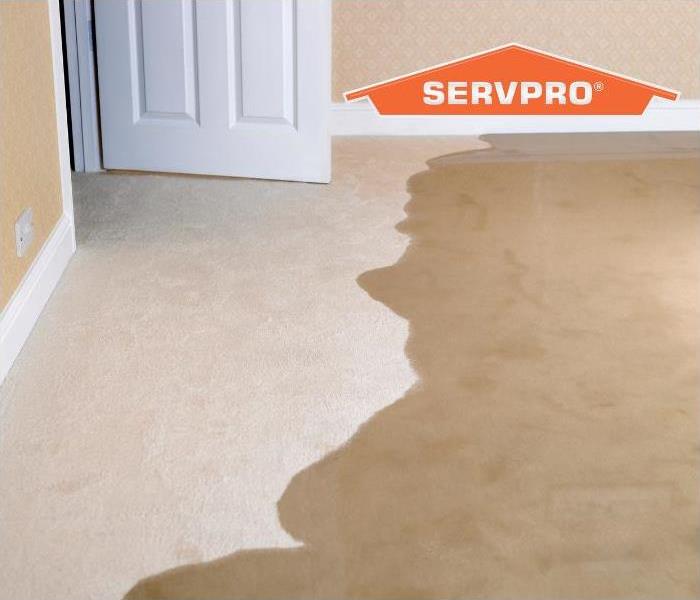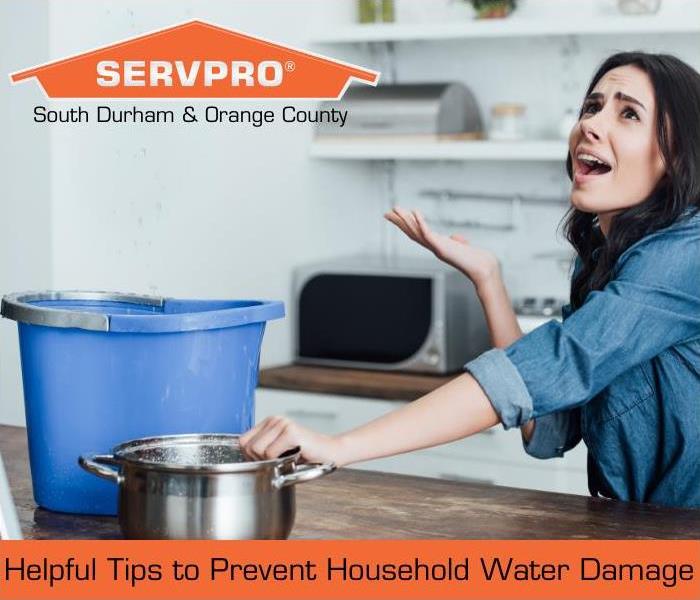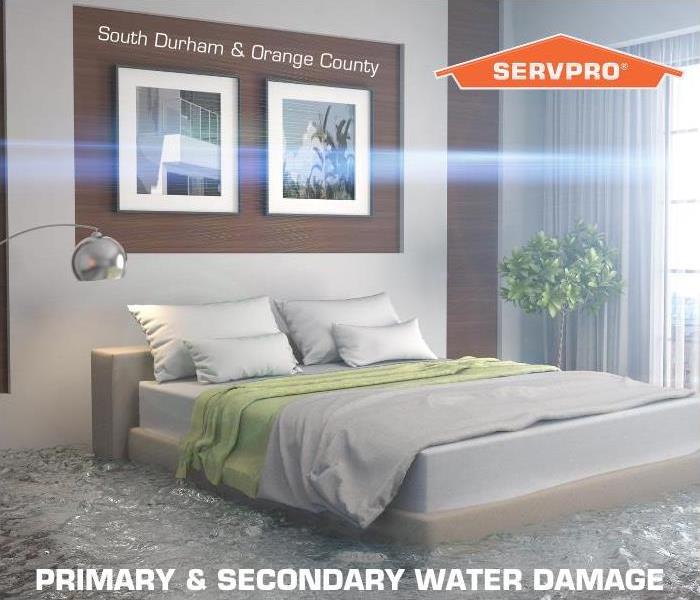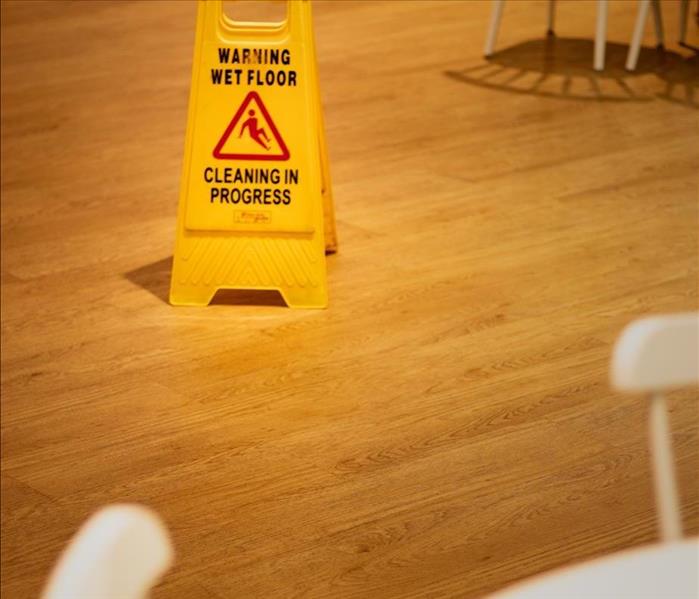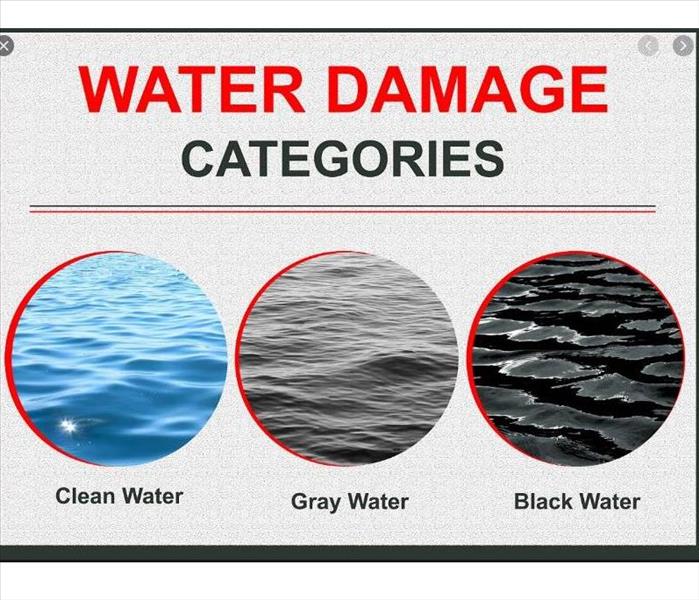Recent Water Damage Posts
Have you ever wondered if there is a connection between the air we breathe indoors and water intrusion?
3/21/2024 (Permalink)
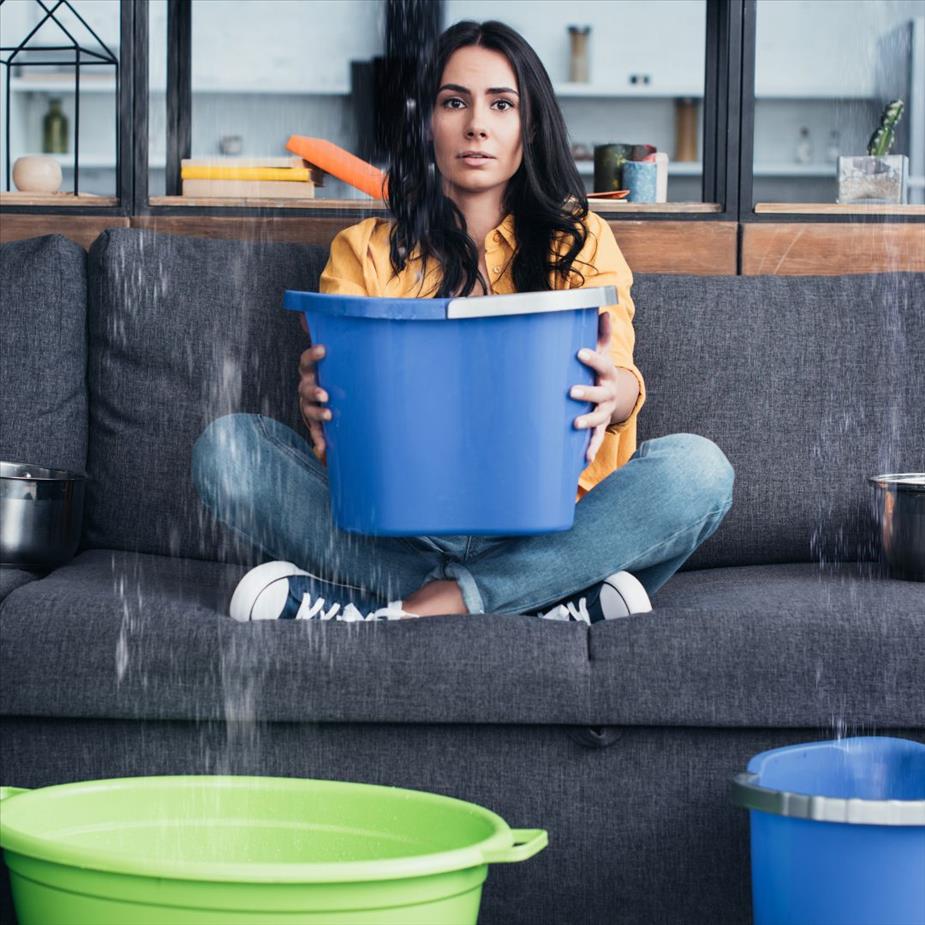 Water intrusion
Water intrusion
The answer is nuanced and depends on how the water intrusion is handled. We will explore the correlation between water intrusion and indoor air quality and shed light on the importance of proper mitigation and drying techniques to prevent compromising the air we breathe.
Generally, a water intrusion that is promptly and properly mitigated will have no negative impact on indoor air quality. For instance, if a burst hot water tank occurs in an apartment, home, or workplace and is handled promptly, the indoor air quality should remain unaffected. The key lies in how quickly the structure is dried and if it follows the IICRC S500 standards for structural drying.
A crucial aspect of preventing any adverse effects on indoor air quality is ensuring that both visible water and bound water are addressed during the mitigation process. While visible water is apparent and can be easily dried, bound water poses a greater challenge, as it seeps into hard-to-reach areas such as wall boards, drywall, and floor joists.
To mitigate bound water effectively, it is essential to engage the services of a true professional water restoration company. These experts utilize specialized moisture reading equipment to map out the extent of water intrusion and take the necessary steps to dry the structure thoroughly, in accordance with the IICRC S500 standards. Only by adhering to these standards can one be assured that no mold or microbial growth will occur, protecting the indoor air quality.
At SERVPRO of South Durham, we understand the critical importance of properly mitigating water intrusions to safeguard indoor air quality. Our team is available 24/7 to address any water-related emergencies promptly and efficiently. We employ the latest equipment and follow industry best practices to ensure your structure is thoroughly dried and restored, in strict adherence to the IICRC S500 standards Water intrusion, if not timely and adequately mitigated, can lead to mold or microbial growth, subsequently impacting indoor air quality. However, by entrusting the task to a professional water restoration company like SERVPRO of South Durham, you can be confident in the preservation of your indoor air quality. Don't hesitate to call if your home or office experiences a water intrusion—we're here to help!
We’re The Boss At Restoring Water Loss!
7/11/2022 (Permalink)
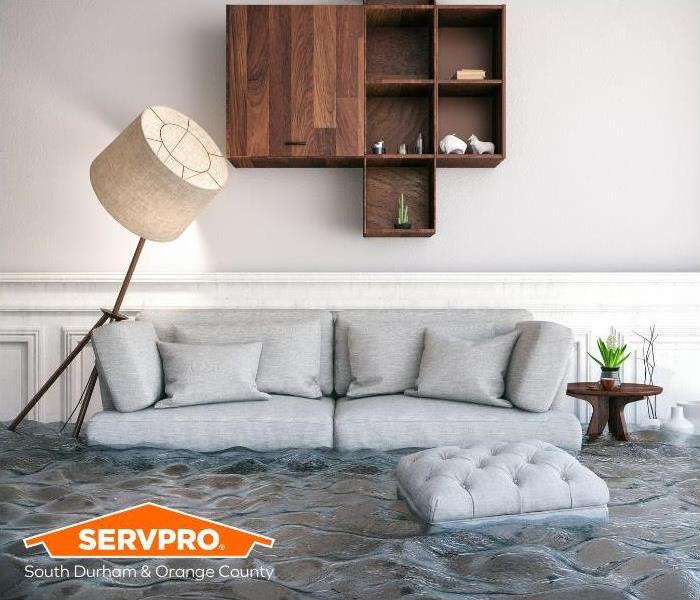 Residential flooding
Residential flooding
Let’s face it: if you are a homeowner, business owner of any kind, tenant, or just a regular human – you’ve experienced a water loss. Depending on the sense of urgency, the resolution is time-consuming and inconvenient resulting in highly costly repairs, displacement sometimes, and in the worst-case scenario irrevocable damage to personal contents. However, your time, money, and contents can be saved. Any resident or business can achieve this by working with a professional, dependable emergency restoration company like SERVPRO of South Durham. As professionals, the first thing we do when your home or business encounters a water loss is to respond immediately! This is important because the amount of time that passes is the amount of time you and the structure are exposed to water damage. The next step is the inspection and water damage assessment of the environment. The inspection and water damage assessment is important because the skill level and experience of your water damage restoration specialist determine how the environment is assessed and what solutions will be employed. Improper inspection leads to improper drying techniques possibly leading to even more costly secondary damage and microbial growth. At SERVPRO of South Durham, our water restoration technicians are IICRC certified and trained to properly address and resolve your water loss according to a set of nationally certified, accredited, and accepted practices by the Institute of Inspection Cleaning and Restoration Certification organization. The next two steps, water removal/extraction, and drying/dehumidification are easily deployed and effective with proper training and knowledge. However, the extraction and drying process are also the two areas where mistakes and ill-advised practices are used resulting in the costliest damage to the structure, contents, and customer experience. Once our water restoration technicians at SERVPRO of South Durham mitigate the water damage, the next step is to begin restoring your life and home or business to preloss conditions. That begins with cleaning and sanitizing the affected environment. This is where the magic begins! We restore your meaningful contents by effectively cleaning, odor removal, and deodorizing then sanitizing with antimicrobial, antibacterial, and disinfectants to assure the highest quality of clean to the affected environment. What can’t be restored, with guidance from you and your insurance adjuster will be properly disposed of and replaced. Restoration, the final step, is the actual process of restoring your business or home to its pre-water loss condition. Restore could involve minor repairs like replacing drywall or major repairs like full-scale reconstruction. No matter how big or small a job, our fully staffed construction team is ready and equipped with the knowledge, tools, and equipment to get any business up and running or any house, home! Don’t let water loss drown your home or business.
When you think, “Cleaning. Restoration. Construction.” Think SERVPRO of South Durham!
When It Rains You Need an Umbrella: Why Flood Insurance is Important
6/22/2022 (Permalink)
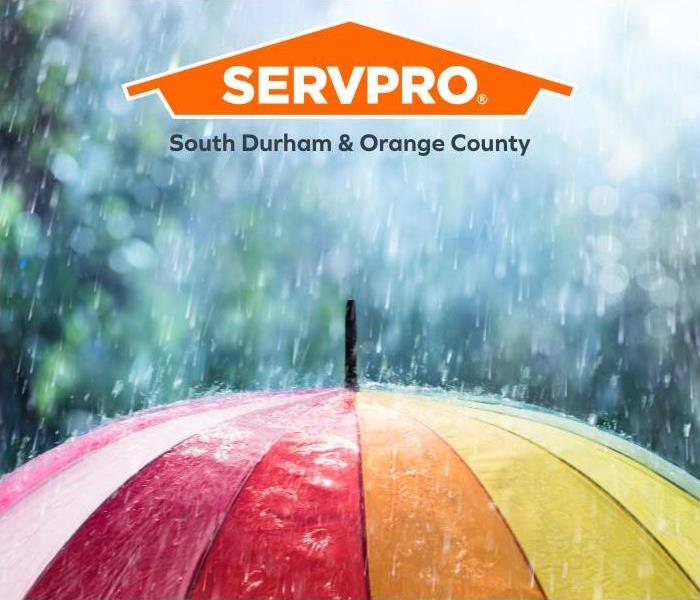
Last week’s blog post discussed the start of hurricane season and how to prepare your home or business against damage. This week’s blog will discuss the importance of flood insurance in the event of a water loss. This is especially important during hurricane season for those living in North Carolina and residing in flood-prone areas. The News & Observer quotes the North Carolina Hurricane Guide as stating, “that 1 inch of water can cost up to $25,000 or more in cleanup and repair!” Interestingly, most homeowners’ insurance and renter’s insurance do not typically cover flood damage. What’s more shocking is that most homeowners and renters are unaware that their policies do not cover flood damage until they experience water loss from an occurrence such as a hurricane or roof leak. At that point, it is too late and the customer is forced to pay out of pocket or use other sources of funding to cover cleanup, restoration, and reconstruction expenses. The average flood insurance claim is $69,000! It is recommended every homeowner and business owner purchase flood insurance; this normally is purchased separately and in addition to your home or business insurance policy. The N.C. Department of Insurance warns against not purchasing flood insurance “because your home is not in a designated flood plain.” Do not assume your home or business will never incur flood damage. In the event, your home or business does experience water or flood damage contact SERVPRO of South Durham! We have an experienced team led by an IICRC Certified Master Water Restorer and highly trained and IICRC certified Water Restoration Technicians, that allow us to quickly respond to losses of all sizes and quickly work to minimize the chances of further damage from flooding or leaks. The most comforting benefit of working with SERVPRO of South Durham during your water loss emergency is that we are available 24 hours a day, 7 days a week!
When you think, “Cleaning. Restoration. Construction.” Think SERVPRO of South Durham!
How to Keep Your Home & Business Afloat
5/31/2022 (Permalink)
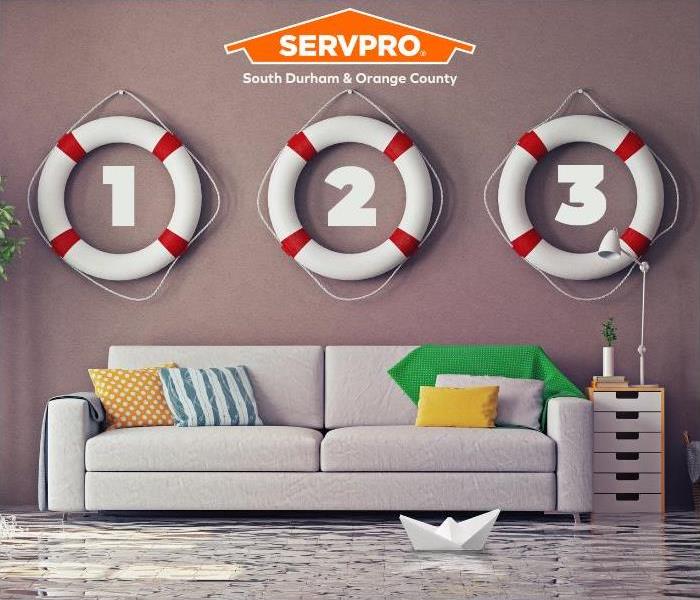
If your home or business has ever experienced a water loss, then you’re aware that the most important piece to resolving the issue and starting mitigation is to stop the source of the water loss. The next most important piece is a timely response to begin mitigation and restoration. One thing that surely impedes the water mitigation and restoration process is not knowing where the source originates or having to find the sources of the loss. Not knowing or having to find the source of a water loss is time-consuming and costly! This can even result in the denial of a claim due to negligence. The best way to keep your home or business afloat in the event of a flood or water loss is to practice effective water loss prevention and preparation behavior for your home and business. State Farm Insurance recommends evaluating pipework consistently, constantly reviewing the water bill, frequently analyzing differences in meter readings, and asking about a leak detection protection system for unusually high water usage to stop and prevent water leaks before they start. Again, determining where water might come ahead of time can go a long way in preventing water damage for a business in the long run as well! Common water sources for water damage in businesses occur mostly in aged appliances, pipes and drains, and roofing. Good preparation and prevention for the exterior of commercial businesses are just as important to monitor and consistently assess as well. Practicing habits like regular roofing maintenance, regular HVAC maintenance, and regularly replacing appliance hosing and piping with upgraded materials or new materials help monitor the chance of leaks or breaks for the business. However, two of the most preventative measures any residence or business can employ is installing an active or passive automatic leak detection system. Not only does this offer a modernized and advanced technology leak system to the structure, but it “detects potential water leaks by either monitoring flows in the pipe or by detecting water on the floor. When flow is irregular or moisture is detected, the valve will automatically shut off the water supply to your home. This may help prevent a significant amount of the damage that water leaks can cause.” Hopefully, the information provided assists you in preventing water loss for your residential or commercial establishment. Whatever size the water damage is to your home or business, our Water Restoration specialists have the experience and equipment to deal with it. Our mitigation and restoration professionals at SERVPRO of South Durham will work closely with you and the other occupants during the restoration process to have as little disruption as possible to your personal life and daily business activities. We are the professionals to restore your home or business to the preloss condition “Like it never even happened.”
When you think, “Cleaning. Restoration. Construction.” Think SERVPRO of South Durham!
There's a Leak in this Old Building
4/8/2022 (Permalink)
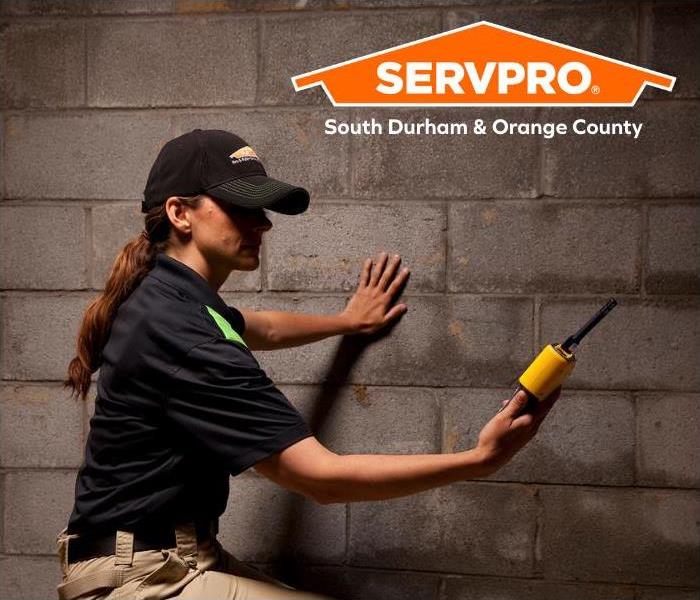
Have you ever walked into an old schoolhouse or a 20-year-old office building and viewed water stains on the wall or ceiling tile? The slow, continuous leak over years may have seemed minor at the time but has now evolved into a costly, full-fledged commercial water loss. In an article, published in Risk & Insurance, The Hartford states that “75 percent of all commercial property water damages losses are caused by an accidental discharge of plumbing, HVAC systems, and appliances.” Dealing with a commercial water loss also exposes the insured to additional costs such as loss of revenue if operations are interrupted, the cost to relocate tenants and or employees, and the cost to rebuild. The risk for water damage in commercials buildings increases due to the design, volume of appliances that utilize water, the related piping systems, or the type of business utilizing the structure. For example, water flows down from a leak on the top floor of a high rise damaging multiple floors or units underneath. However, the risks for water losses can be mitigated and repair costs lowered by incorporating a water mitigation response plan through the use of technology. SERVPRO of South Durham provides a free tool, called an ERP (Emergency Ready Plan), that provides an immediate plan of action of knowing what to do, what to expect, and who to call in advance. This minimizes crucial time by providing information in a central location that can be accessed remotely from anywhere by any individual who is granted access. This allows for a quick response, thus reducing secondary damage, business interruption, and confusion by staff that essentially requires the crucial time needed to address the loss and begin the mitigation process. It is important for commercial property management, superintendents, and facility managers to proactively incorporate an emergency mitigation response plan through technology to reduce the risk of a large water loss. The longer time it takes to locate the source of a water loss and start mitigation means the longer it will take to dry the affected materials and the more money it will cost. If you want to be prepared for your next commercial loss using the free ERP tool in the South Durham area, please reach out to tony.lucas@SERVPROsouthdurham to schedule your appointment!
When you think, “Cleaning. Restoration. Construction.” Think SERVPRO of South Durham!!!!
The Problem with Standing Water...
3/4/2022 (Permalink)
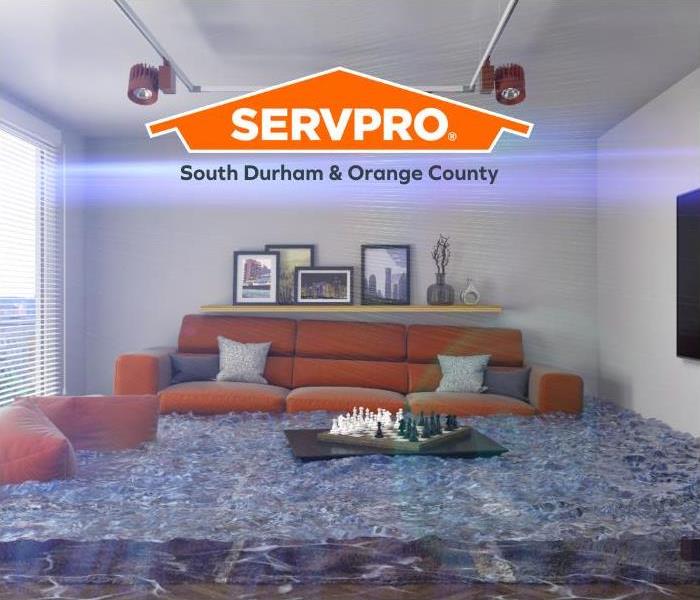
As an IICRC water damage restoration specialist, I am here to tell you, eventually, your business or home will experience a water loss. Water loss by far is the most common emergency in the industry. Generally, most water loss categories are mild in comparison; meaning the water loss is coming from a clean source and poses no substantial risk of causing sickness or discomfort. When you think of clean water sources, think of supply lines to fixtures or appliances. The problem with water losses, even from a clean source, is that condition of the environment will almost always likely influence natural biological changes in the condition of the water. Simply put, time is never on your side when dealing with a water loss. In as little as 24-48, biological growth can begin to develop in and when exposed to water. This can lead to mold spore colonization, growth, and spreading if not promptly and properly handled. Water that has been trapped over a while or not effectively dried can damage structures or materials to an unsalvageable or unrepairable state. While exposure to bacteria and fungi is essential to life, prolonged exposure to an excessive amount of certain biological growth that colonizes or is not properly remediated from a water loss can lead to health complications. What may seem to be minor when it comes to a water loss has proven to have major effects if not addressed properly. That is why SERVPRO of South Durham employs Certified Water Damage Restoration Specialists, Structural Drying Technicians trained to effectively dry materials, and Mold/Microbial Remediation Specialists available 24hrs a day to assure that in addition to primary damage from water loss, no secondary damage is influenced due to prolonged exposure or ineffective drying techniques! Check out some additional information on the Centers for Disease Control and Prevention for some proactive ways to prevent waterborne germs in your home! Lastly, when you think, “Cleaning. Restoration. Construction.” for your water loss, think SERVPRO of South Durham!
When It Rains, It Pours
1/28/2022 (Permalink)
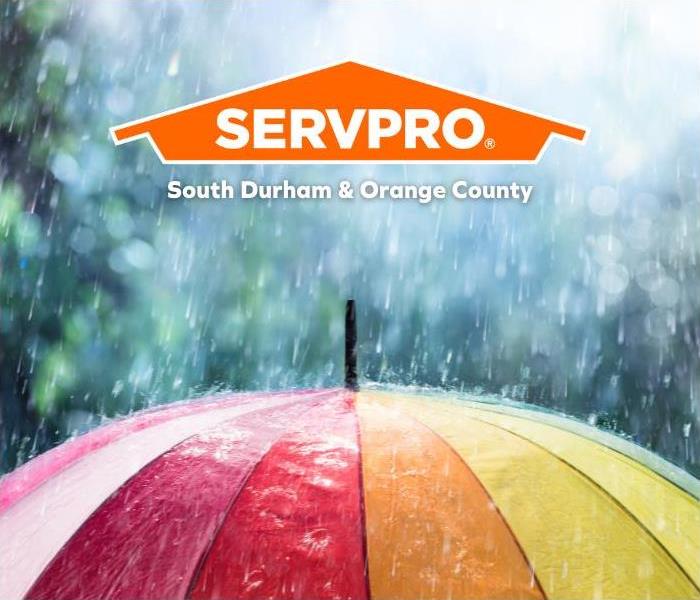
The great Benjamin Franklin once said, “In wine there is wisdom, in beer there is freedom, in water there is bacteria.” If you’re a homeowner or business, one of the most timely and costly threats to your dwelling and personal belongings is the intrusion of water that will result in water damage. While most homeowners and businesses find it appropriate to bring out the mop, industrial yellow mop bucket, and residential grade fans to fix water damage; it is always most often the water you don’t see from prolonged leaky plumbing, storm water damage, or water damage from a fire that causes harmful bacteria and mold, rotting to the structure, and more importantly – damage to your personal belongings. Forbes Advisors states, “Every year, about one in 50 homeowners will file a water damage or freezing claim, accounting for almost 24% of all homeowners insurance claims, according to the Insurance Information Institute. The average cost of water damage or freezing claim is about $10,900.” The goal to avoid costly future restoration and irrevocable damage to personal belongings is an immediate response and effective drying. Equipped with advanced water inspection, extraction, and drying equipment, a SERVPRO of South Durham water restoration specialists, available 24 hours a day (including holidays), will be on-site, uniformed, and initiating water mitigation services within four hours of loss to offer an immediate response when your water emergency happens! Remember, the quicker the water is removed, the less costly the damage, cleanup, and restoration to your commercial or residential property “like it never even happened.”
Can a Water Intrusion Impact Indoor Air Quality?
8/20/2021 (Permalink)
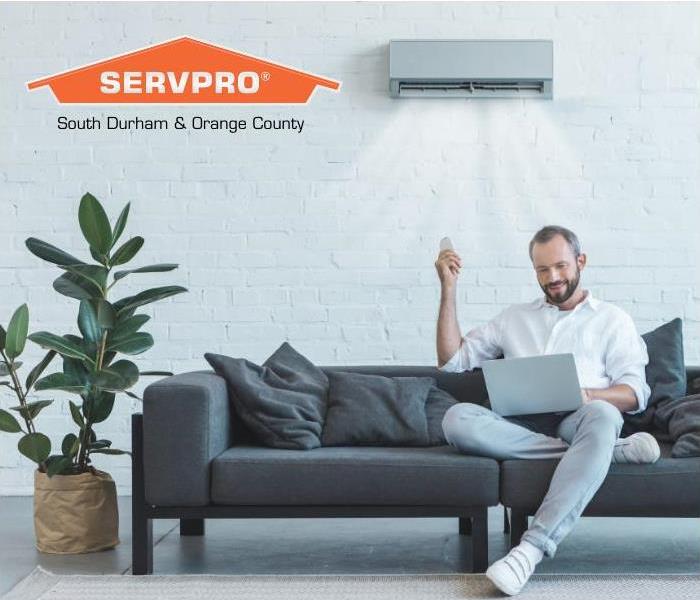 Can a Water Intrusion Impact Indoor Air Quality?
Can a Water Intrusion Impact Indoor Air Quality?
Is there a correlation between the air we breath inside our homes or workplace environments and a water intrusion? This question has a layered answer that is dependent on how the water intrusion is handled.
A water intrusion, for example, from a burst hot water tank in an apartment, home, or workplace that is properly mitigated will have no impact on the indoor air quality. The key to this or any other water intrusion and its impact on the indoor air quality is totally based on how quickly the structure is dried and if it properly dried out according to IICRC S500 standards for structural drying. A properly mitigated and dried structure not only addresses the visible water but addresses bound water that seeps behind wall boards, quarter round molding, water that seeps into drywall or walls, water trapped in studs and floor joists or water that that is trapped beneath vinyl, tile, laminate, or hardwood flooring. When bound or trapped water is not properly mitigated, meaning dried properly, microbial, or fungal growth will occur, and the spores released from these microorganisms will have an affect on the indoor air quality.
A true professional water restoration company will use the proper moisture reading equipment to map out where the water intruded and take the necessary steps to dry the structure according the IICRC S500 standards. Then, and only then can you be assured that the water intrusion will not lead to mold or microbial growth that will impact the indoor air quality.
SERVPRO of South Durham and Orange County provides 24/7 service for any water emergency. Call us at 919-596-1242 if your home or office has a water intrusion.
Immediate Action Steps for Homeowners with a Water Intrusion from a Clean Source
6/2/2021 (Permalink)
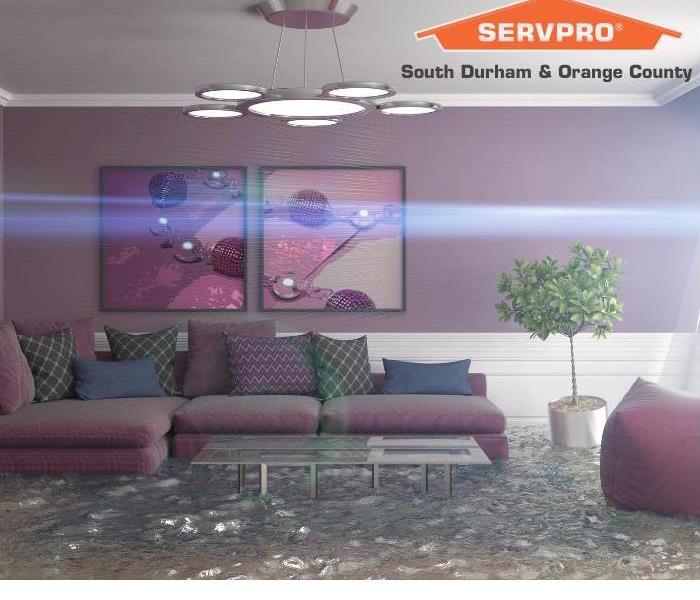 Water Damaged Residence in Chapel Hill, NC
Water Damaged Residence in Chapel Hill, NC
You inadvertently left the water running in the tub and it overflows onto the flooring in the bathroom, hallway and into the bedroom. You recognize your mistake as you step onto the soaked carpet. Your mind is racing; your heart rate is elevated. What do you do now?
- First shut off the water at the source to prevent additional damage.
- Turn the circuit breakers off to cut the power to affected rooms to prevent electric shock.
- Get up as much excess water as possible through moping or a shop vacuum.
- Call SERVPRO to start the mitigation process.
- Call your insurance company to start a claim.
- Put wood block or aluminum foil under the legs of furniture to prevent damage.
- Remove paintings and art to a safe dry area. Also remove any valuables from the area
- Hang drapes with coat hangers to keep them from absorbing water from wet carpet and flooring.
The key to mitigating any water intrusion is timeliness. Don’t panic. Take the steps above and know that everything will be okay because SERVPRO will make it "Like it never even happened."
The Correlation between Primary and Secondary Water Damage
5/25/2021 (Permalink)
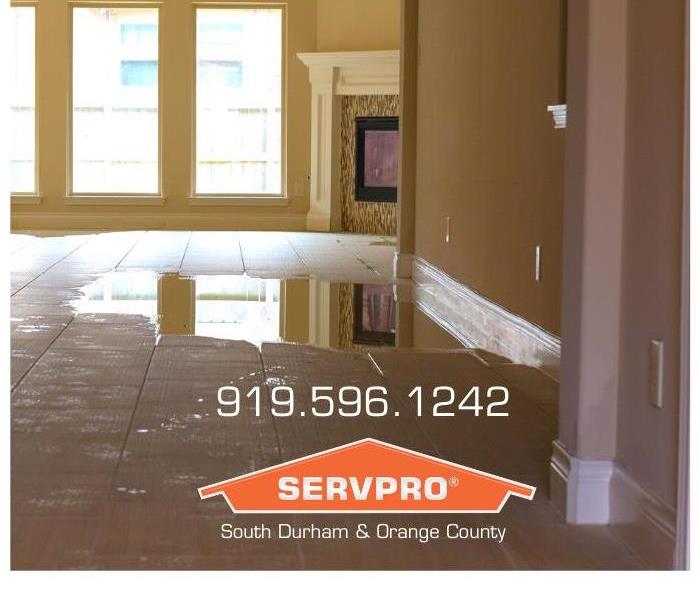 Water Damaged Residence
Water Damaged Residence
Any water intrusion that occurs within a home or commercial building has an immediate effect on building materials and can potentially have a secondary effect as well. The immediate impact a water intrusion has on building materials is known as primary damage. Primary water damage is caused by the direct impact of water on the building material. Secondary water damage is caused by the impact that water has on the material over time.
An example of primary water damage is discoloration of a building material when it comes in contact with water. Another example of primary damage is the crumbling of plaster or drywall due to water saturation.
An example of secondary water damage is the loss of structural integrity and microbial growth. Wood when it stays wet for an extended period will rot and organic building materials when they are exposed to water over an extended period, as little as seventy-two hours, will develop mold or microbial growth.
Even when the water is not in direct contact with the materials the moisture content in the air can cause secondary damage to hygroscopic or water loving, building materials. Elevated humidity or humidity levels in excess of 60% are conducive to mold growth which will impact porous or hygroscopic building materials like drywall, carpet, and wood. For the aforementioned reasons, proper mitigation is an urgent necessity. A professional water damage company can help minimize the damage caused by a water intrusion and prevent secondary damage by establishing a proper drying system. If you experience a water intrusion, call SERVPRO of South Durham and Orange County at 919-596-1242.
Extraction and Dehumidification
5/21/2021 (Permalink)
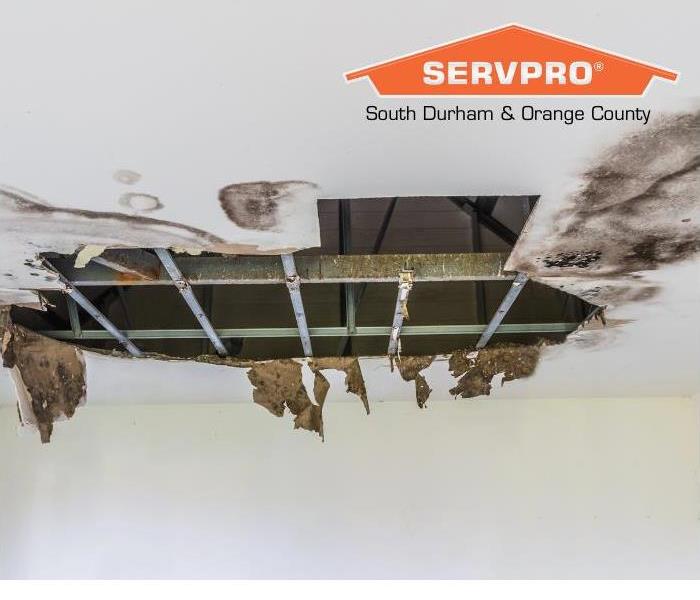 Water Damage to ceiling
Water Damage to ceiling
A burst pipe pumps gallons of water onto your floors and the walls and ceiling. Mopping up the water is not enough to remove all the water. Shop vacuuming the water is also not enough to adequately remove the amount of water that is damaging the home. Professional water mitigation is necessary to properly extract the standing water and then implement the proper evaporation system to remove water that has been absorbed into building materials and contents.
Removal of certain materials may also be necessary to remove bound water that is trapped behind molding or underneath vinyl or laminate flooring. Another important element of proper water damage restoration is to create a balanced drying system which utilizes proper airflow to create evaporation along with dehumidification to remove the evaporated water. Utilizing the science of structural drying assures that the building materials will dry quickly and efficiently to prevent secondary damage such as mold growth. Water damage restoration is not a do it yourself project and should be left to properly trained professionals like SERVPRO of South Durham and Orange County. If you have a water damage event don’t hesitate to call 919-596-1242.
What is a Category 3 Water Intrusion
4/30/2021 (Permalink)
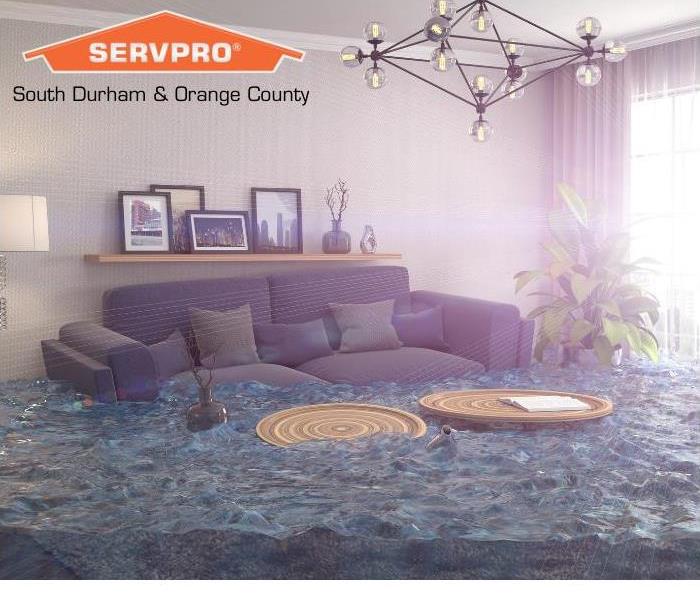 Category3 water damage in flooded home
Category3 water damage in flooded home
A water intrusion where the water is grossly contaminated is referred to in the water mitigation and restoration industry as a Category 3 water intrusion. Highly contaminated water is extremely unsanitary, carries pathogens which are disease causing. Another term for Category 3 water is black water. A Category 3 water intrusion can originate from a toilet discharge that originates beyond the toilet trap. This is known as sewage and originates from the septic system. Another lesser known Category water intrusion can come from the surface of ground water that intrudes inside a building. This type of water is mostly seen in flood waters, but can occur from a large rain or thunderstorm where water intrudes inside the structure.
Due to the health effects of a Category 3 water intrusion, restorers must wear appropriate proper protective equipment to protect themselves from the health effects associated with mitigating this type of water intrusion. Safety is not only important for the restorer but also for the occupants of the building. People with compromised immune systems, young children and the elderly are at higher risk to suffering health related effects by coming in contact with Category 3 water.
In order to properly mitigate a category 3 water intrusion all porous materials must be removed which includes, carpet, underlayment or pad, drywall, and insulation. Proper cleaning solutions that kill microorganisms and pathogens must be used to sanitize the surface of all nonporous materials. Category 3 water intrusions are not to be taken lightly and should be reserved for professionals.
Does it take that many fans to dry my home?
4/8/2021 (Permalink)
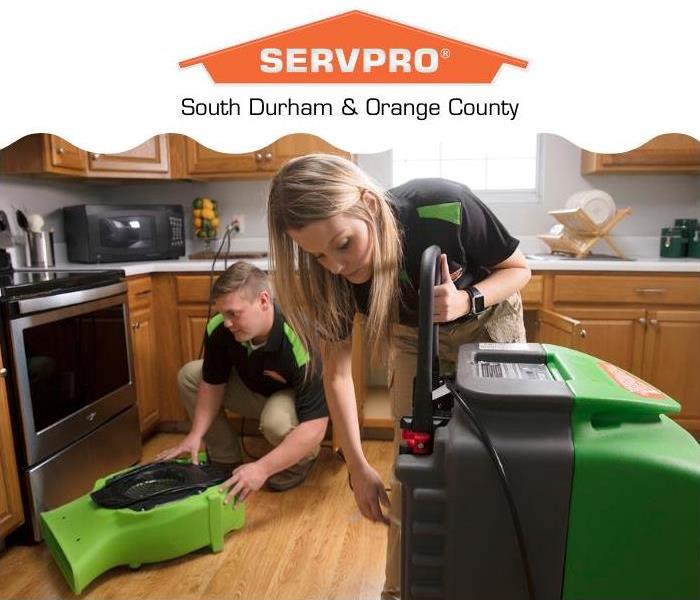 SERVPRO of South Durham and Orange County Water Damage Restoration Training
SERVPRO of South Durham and Orange County Water Damage Restoration Training
A supply line ruptures on a toilet and affects the bathroom, the adjoining room, hallway, and another bedroom. SERVPRO is called to remediate the damage. The homeowner, having never experienced a water damage situation, is shocked that so much equipment is placed in the home to dry the structure. The burning question, the elephant in the room, is does it really take that much equipment to dry the structure, or is SERVPRO attempting to escalate the bill? The answer to that question is that it does take that much equipment, and there is science and a standard to validate each piece of equipment.
Homeowners can be assured that SERVPRO, in placing equipment to dry a home is not, and will not attempt to place more equipment in a home than is required. SERVPRO follows the industry standards for drying established by the Institute of Inspection Cleaning and Restoration Certification (IICRC) in the industry standard known as the S500. This standard is used by all certified water mitigation specialist. The standard is based on a science of dry called psychrometrics. The application of psychrometrics by industry professionals is to dry the structure as quickly as possible and prevent additional damage such as mold growth, delamination of carpet, cupping of hardwoods and numerous other secondary damages that can be caused by water absorption into materials. The standard used for drying is used by all insurance companies and adjusters and must be followed by restorers doing work for their insured. This is verified by way of a drying log. SERVPRO uses a system called DryBook that tells crew chiefs and technicians exactly how much equipment to place in a given area based on the percentage of affected area in a room. This assures that each job is done according to standard.
SERVPRO makes that drying log available to not only the insurance adjuster but the homeowner as well. SERVPRO is transparent in its process and desires to keep happy customers willing to pay. Although water damage is traumatic and disruptive, SERVPRO will make it "Like it never even happened."
Clogged Gutters and Water Damage
2/10/2021 (Permalink)
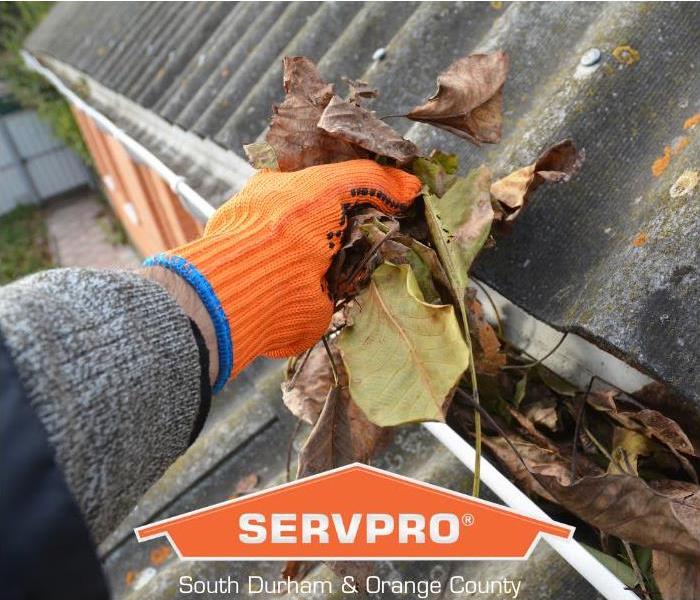 Clogged Gutters and Water Damage
Clogged Gutters and Water Damage
A painted seamless gutter on a house is aesthetically pleasing to eye and adds to a home’s curb appeal, but gutters serve a greater purpose than looks when it comes to protecting your home from water damage.
Gutters are designed to transport rain water from the roof to the downspouts and away from the home. A gutter system that becomes clogged with leaves and debris such twigs, and nuts can lead to significant damage to a home. Most people don’t realize the large volume of rain water that is moved by the gutters. Every square foot of the roof collects six gallons of water in 1 inch of rainfall. 1800 square feet of roof transports a staggering 10,800 gallons per inch of rain. When the gutter becomes clogged the water can only flow over the sides, or back up behind the gutter, causing damage to the fascia and roof deck boards. When these areas get wet it can lead to leaks, mold and long term wood rot.
Water Damage due to clogged gutters is not limited to just rainwater, a clogged gutter can also lead to ice damning in the winter. This is where the water in the gutter track freezes, and pushes the shingles up as it expands when it freezes. When it melts the roof deck and or ceiling of the home becomes wet.
To prevent water damage from clogged gutters it vital that the gutters be cleaned of debris. Another solution is to have gutter guards or caps placed on the gutters to eliminate anything other than water from entering the gutter.
If you are experiencing water damage due to a clogged gutter system, SERVPRO of South Durham and Orange County can help once the gutter system has been cleaned, by properly drying the structure and performing any necessary mold remediation.
Moisture Mapping, What is it and Why Does It Matter?
11/13/2020 (Permalink)
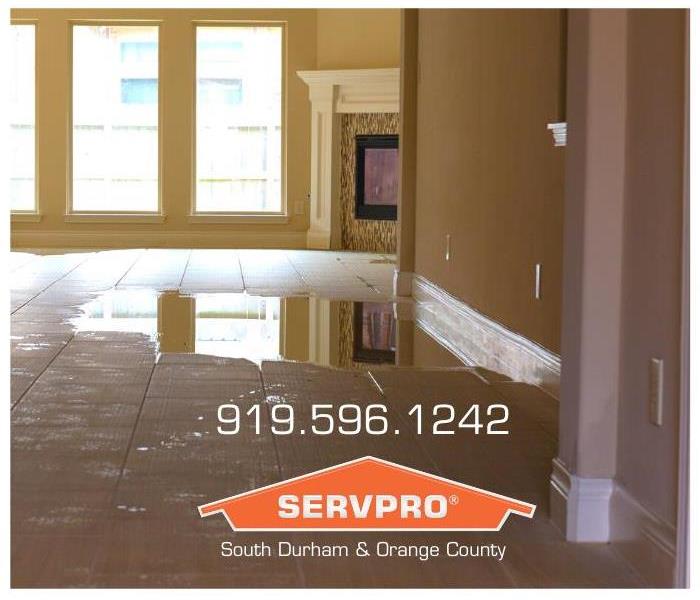 Water Damage
Water Damage
Moisture Mapping, what is it and why does it matter when you have a water damage emergency? In a water loss situation, it not just the water that is seen that can cause significant damage to a property and its contents, but also the unseen water, that is not visible to the naked eye that can cause serious damage. Moisture mapping is the detailed process to identify all areas of water migration, using specialty tools to detect the moisture content of building materials, so they can be dried properly.
Improper drying due to unseen and undetected water can cause mold as well as rot if the materials stay wet for an extended period of time. This is often most evident in a situation such as a bathroom or kitchen where a water damage occurs. A supply line to the toilet or a water line to an ice maker breaks and flows onto the tile or vinyl flooring. It is quickly detected by the homeowner. They are able to stop the water flow and proceed to get the water up with towels and a shop vacuum. Due to their lack of understanding the migration pattern of water and moisture mapping, they think the job is done. Within a few days or weeks they notice a musty smell or observe discoloration on the flooring. It is then they call for a mold assessment. During the initial water loss, moisture mapping was crucial to detect water that had migrated behind baseboards, under flooring, inside wall cavities, behind cabinet kick plates or had migrated into the crawl space. Water damage Restoration professionals use moisture meters, penetrating and non-penetrating to detect water migration into these areas. Then they are to use the proper equipment, according to industry standards to effectively dry the structure and prevent the secondary damage caused by improper drying.
If you have a water damage emergency, don’t do it yourself. Call SERVPRO of South Durham and Orange County at 919-596-1242.
My Carpet is Wet, Now What?
10/9/2020 (Permalink)
One of the primary building materials found in both residential and commercial buildings is carpet. Carpet comes in many different styles from traditional cut-pile to Berber and commercial glue down. In a water damaged environment carpet is one of the most common building materials restoration companies, like SERVPRO of South Durham and Orange County are faced with mitigating and restoring if possible. Salvaging damaged carpeting is not a one-size fits all application, but varies based on category of water loss and current condition of carpet
The water loss category as classified in the restoration industry is the determining factor denoting the amount of contamination in the water.
- Category 1 is clean water that may be found when an ice-maker line ruptures. If the restoration process begins within hours of occurring the likelihood of salvaging the carpet is extremely high.
- Category 2 is a reference to gray water which has picked up some forms of contamination, for example water from the dishwashing machine or an overflow of washing machine. The soap, food particles and soil combined with the water make the water a Category 2 water loss. Salvaging carpets under this condition is also extremely high, but the emergency service of drying must begin quickly to prevent the current category from progressing to a Category 3 and rendering it unsalvageable.
- Category 3 water damage is denotes gross contamination and hazardous. This can be raw sewage or water damage that started as another category due to prolonged interaction with bacteria and other pathogens on the building materials that populate due to the increased moisture content. Category 3 water damage is not considered salvageable in most cases.
An additional matter of consideration as to whether carpet is salvageable is its current condition. Pre-existing conditions such as delamination, separating seams, fiber loss and frayed fibers are determining factors as to whether a carpet can be salvaged and restored.
If you have experienced any type of water loss, mitigating the damage quickly is essential to prevent a bad situation from becoming worse. Call SERVPRO of South Durham and orange County at (919)596-1242 and we will make it “Like it never even happened.”
Helpful Tips to Prevent Household Water Damage
9/28/2020 (Permalink)
Household water damage can be a very traumatic and costly experience that no one looks forward to experiencing. However, outside of purchasing homeowner’s coverage very few people go any further to prevent potential water losses. This is largely because most people rarely think about the potentiality of it occurring to them, thus they fail to plan. The reality is that on average homeowners will experience one water loss during a twenty year time period. Planning for prevention is a wise strategy to mitigate the impact of a water loss, if and when the time comes. Here are some helpful, inexpensive and simple tips to employ to prevent or mitigate the impact of water damage to your home.
- Check your water heater for rust and leaks. Make sure the water pan isn’t about to overflow. If it is have it serviced.
- Have your dishwater and HVAC unit serviced to make sure it is in proper working order.
- Cut the water off at the washing machine when not in use.
- Replace supply line hoses to the toilet every four to five years.
- Turn water off at toilet supplies when leaving the home for extended periods of time.
- Install a water monitoring sensor to the hot water tank.
- Allow faucets to dip during freezing conditions to prevent the lines from freezing.
- Keep the heat running even when away during freezing conditions.
- Make sure pipes are properly insulated.
- Have roof inspected for loose or missing shingles.
- Cut water off to the whole house when leaving for vacation during spring, summer or fall. This can be done by purchasing a simple tool at your local hardware store and turning the main valve off at the street.
- Purchase a moisture meter and check your walls and floors for excessive moisture periodically.
Although these tips are sound and easy ways to prevent or mitigate water damage, they are not guarantee that a loss won’t occur. If you do experience a water loss and need help to mitigate the damage, call SERVPRO of South Durham and Orange County at (919) 596-1242.
Primary and Secondary Water Damage
8/24/2020 (Permalink)
A water intrusion can have immediate and long-term effects on building materials and contents such as furniture, electronics, art work, clothing and more. The immediate effect that water has on materials is known as primary water damage, the long-term effect that water has on materials is referred to as secondary water damage.
Immediate, primary water damage is evident when a large volume of water comes through an upstairs floor and into the ceiling below. The weight of the water which causes the ceiling to sag and the drywall tape to pull apart are examples of primary water damage. Another example would be when water comes in contact with particle board which is used to make many types of furniture; the swelling of the particle board is immediate and irreversible. Materials that are not made to encounter water and suffer immediate damage cause primary water damage.
Secondary water damage occurs over a period of time. Excess humidity caused by a water intrusion and materials that are hygroscopic, or easily absorb water, are susceptible to secondary water damage. Secondary water damage includes loss of structural integrity, dimensional changes and microbial growth.
Both primary and secondary water damage can be costly; however, the total impact and dollar value of the loss can be mitigated. It is important to start the mitigation process immediately, which includes extraction of water, setting drying equipment and implementing controls to prevent secondary damage. If you are experiencing a water damage emergency don’t delay – call SERVPRO of South Durham and Orange at 919-596-1242 any time, day or night.
Oh No! Water Damage and My Hardwood Floor
5/22/2020 (Permalink)
One of the most common calls our franchise receives is from customers in distress over a water loss event impacting their hardwood flooring. The #1 question they have is, “Can my floors be saved?” It is a well-known fact that water causes significant damage to hardwood flooring. Wood is hydroscopic, meaning it absorbs moisture from the air, and is subject to catastrophic damage if not dried quickly. Our customers have every right to be concerned, but the answer to the question as to whether the floors are salvageable is not a yes or no response, but depends on numerous variables that must be accessed by our ICRC certified technicians. These include:
- Category of water loss
- Class of water loss
- Amount of time flooring has been wet
- Type of hardwoods
Category of water loss simply defined relates to amount of contaminates in the water. A Category 1 water loss is indicative of clean water from a burst pipe. A Category 2 water loss contains significant levels of contaminates, such as an overflowed washing machine or dishwasher. A Category 3 water loss contains gross levels of contaminations including harmful pathogens and toxins and could be the result of sewage or a toilet back flow. A Category 1 water loss is the most likely category for hardwoods to be saved because the water is clean. A Category 3 water loss is not salvageable. However the amount of water impacting the floors, which is indicative of the Class of water loss, has a significant bearing on how much absorption of water the floors will take in and has a direct correlation to flooring damage.
There are 4 Classes of water loss. The greater the amount of water directly impacting the hardwoods the more likely it is for water to penetrate the joints and impact the sub floor. Once water is trapped in the flooring joints it would requires specialty drying equipment, making it a Class 4 water loss. SERVPRO of South Durham and Orange County has specialty drying systems to remove moisture trapped in the joints of hardwood flooring.
Time or Duration of Moisture is a huge factor in determining whether hardwood flooring can be saved. It is imperative to respond immediately. The longer the flooring stays in contact with the water the more damage it creates limiting the chances of saving the floors. Hardwood flooring that is mitigated within the first 24 hours has the greatest chance of being salvaged.
The Type of Hardwood Flooring is a critical factor as to whether the flooring can be saved. Real Hardwood flooring is made out of a single layer of wood, and is salvageable if mitigated in time and is not a Category 3. Although water in the subterranean layer will cause the ends to bow upwards a condition called cupping, the floors can be sanded down and refinished. Engineered hardwood flooring is made of multiple layers of wood going in different directions. The veneer finish cannot be sanded and refinished. Often when engineered floors are impacted with moisture the expansion of the wood will result in a cracked finish or the popping up of the wood because it expands in all directions. With these conditions present, the engineered hardwood flooring cannot be saved.
Regardless of whether the floors can be saved or have to removed, SERVPRO of South Durham and Orange County can help clients through the mitigation and the restoration process, making it "Like it never even happened."
Water Damage and Odor Control
5/21/2020 (Permalink)
One of the first things homeowners often notice in a water damage environment is the persistent, unbearable malodors. There have been times where homeowners had a small water loss that they felt was unnecessary to call a restoration company to dry because they felt they could easily handle it themselves, until the manifestation of odors forced their hand. The looming question is why does it seem that water damage and odors go hand in hand?
Moisture is one of the key components in odor creation as microorganisms, such, as mold, fungi, and pathogens and other bio-pollutants need it flourish. In a water damaged environment the moisture creates a suitable environment for them to multiply. The organic materials, such as wood, drywall and carpet backing found in homes are the food source these organisms thrive on. They are already present in most home environments, but at very low levels; because without moisture they are unable to survive. This is one of the reasons why proper drying to the IICRCS500 standard is necessary for each water damaged environment. When water is trapped under flooring, behind baseboards, wall cavities, and behind toe kicks of cabinets and is not properly dried it creates the conditions for exacerbated microbial growth and the mycotoxins they release are the odors that are smelt. These malodors are a warning of danger and it is a well-known fact that water damaged environments can pose serious health risks if not properly mitigated. The number 1 reason for residual malodors in a water damaged environment is improper drying.
The solution to odor elimination is to remove the source of the odor and this is not done by spraying air freshener and masking the odor. The well trained water restoration specialists of SERVPRO of South Durham and Orange County will not only treat the odor, but will leave you with the peace of mind that your home or business has been returned to a condition 1 , level of dryness, which is the drying goal of the industry standard aforementioned. SERVPRO of South Durham and Orange County will make it "Like it never even happened."
The Dynamic Duo of Air Movers and Dehumidifiers
5/8/2020 (Permalink)
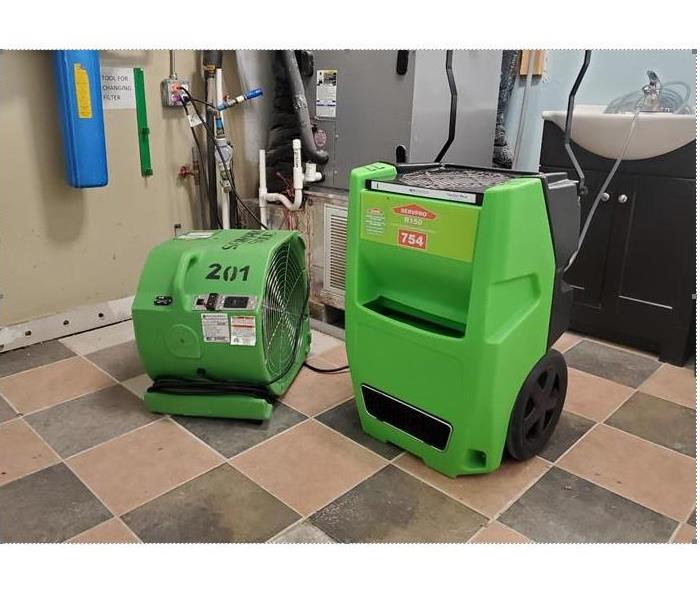 Our signature green air mover and dehumidifier at work.
Our signature green air mover and dehumidifier at work.
Like the superhero Batman, who was armed with a utility belt with gadgets to fight crime, every SERVPRO crew chief and technician is armed with a formidable arsenal of air movers, dehumidifiers and the science behind them, to thwart the perils associated with water damage. The science of water damage mitigation is called psychometrics.
- Psychometrics is the scientific relationship between temperature, humidity and air flow.
Understanding the aforementioned relationships allows the SERVPRO team to dry materials quicker and more thoroughly.
When materials such as flooring, walls and ceilings are wet the SERVPRO crew will extract any standing water because the most effective means of drying is removal of the water. Once the standing water is extracted and areas where trapped water could be located have been opened, the dynamic duo of air movers and dehumidifiers comes into play.
The Air Mover is engineered to create high volume air flow across a wet surface increasing the rate of evaporation which is the process of turning a liquid into a gas. The air mover alone is not enough, in order to be most effective, adequate temperature and proper dehumidification are required. The higher the temperature the more moisture molecules the air can hold. This accelerates evaporation.
The Dehumidifier is a piece of drying equipment that pulls the moisture created by evaporation out of the air and collects it so it cannot re-evaporate. Dehumidification also lowers vapor pressure and reduces the relative humidity which allows the wet materials to dry quicker. Vapor pressure is the force exerted by water vapor (humidity) in the environment. The area with the greatest amount of moisture will have the highest vapor pressure and it will seek equilibrium or balance. The danger with this is that moisture created due to water damage in one area will spread and cause secondary damage in adjoining areas if not mitigated properly.
The SERVPRO team uses the science of psychometrics along with the dynamic duo of air movers and dehumidification to quickly and effectively dry your structure and get you on the road to recovery; making it “Like it never even happened.”
Categories and Classes of Water Damage
3/10/2020 (Permalink)
Not everyone knows that water damage has different categories and classes, and just because it is a low category doesn't mean that is is a low class.
Categories of Water Damage
Assessing the severity of the damage is important for determining what is needed to start the water loss repair and mitigation.
Category 1 - clean water, or water that does not pose a threat to humans. Possible causes of this type of damage include broken appliances or sink overflows.
Category 2 - gray water, this means that the water is contaminated and may cause sickness if ingested. This type of water contains microorganisms. Broken toilets, broken sump pumps and seepage may cause category 2 water damage.
Category 3 - black water, this type of water is unsanitary, as it contains bacteria and other organisms that cause sickness. The possible sources of black water damage include sewage problems and contamination of standing water.
Classes of Water Damage
The class of damage is important when assessing water damage repair options.
Class 1 is the least harmful form of damage. Materials absorb very little of the water from this type of damage. Water damage repair is the easiest in this type of situation.
Class 2 has a fast rate of evaporation, which means that carpets and cushions may be damaged. Water damage repair is more difficult when it involves class 2 damage.
Class 3 has the fastest rate of evaporation. In this case, the water may come from broken sprinklers or other overhead sources, soaking the walls and furniture.
Class 4 requires special water restoration and water removal procedures. This type of damage may affect hardwood floors, plaster and concrete.
If your home or business experience a water loss or water damage, call us here at SERVPRO of South Durham and Orange County, the leading water removal and restoration company, dedicated to protecting your biggest investment, at 919-596-1242.






 24/7 Emergency Service
24/7 Emergency Service















